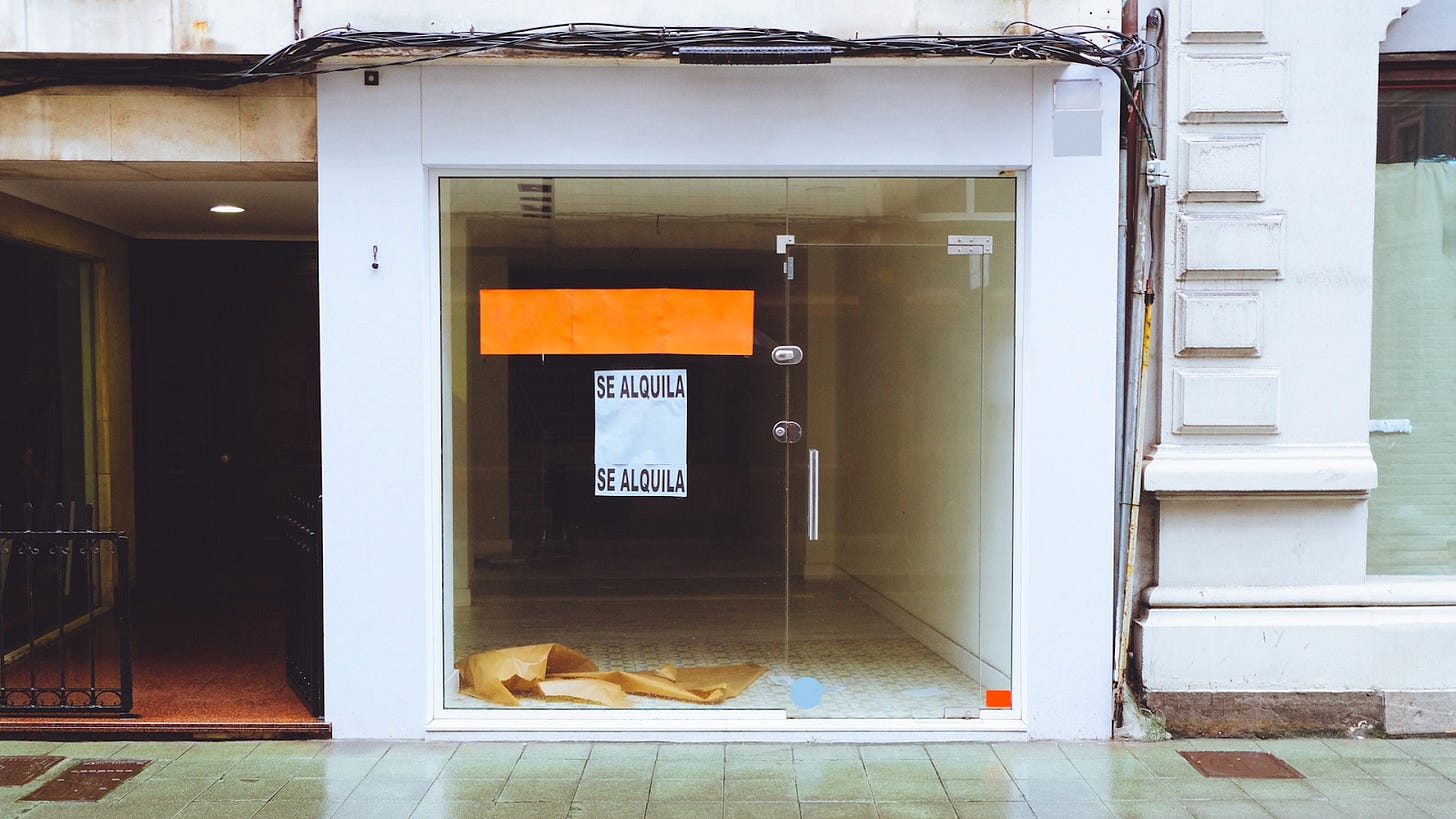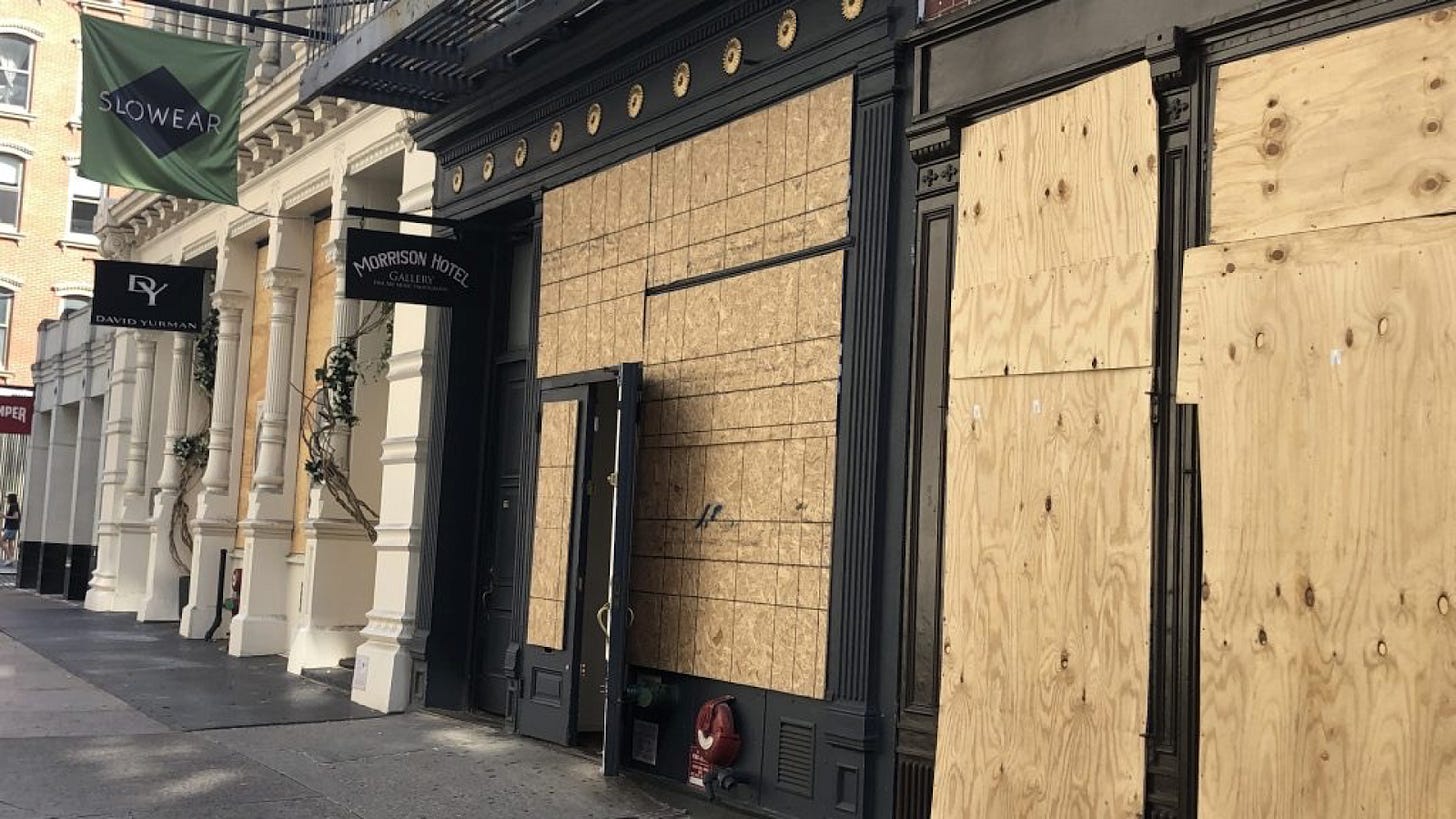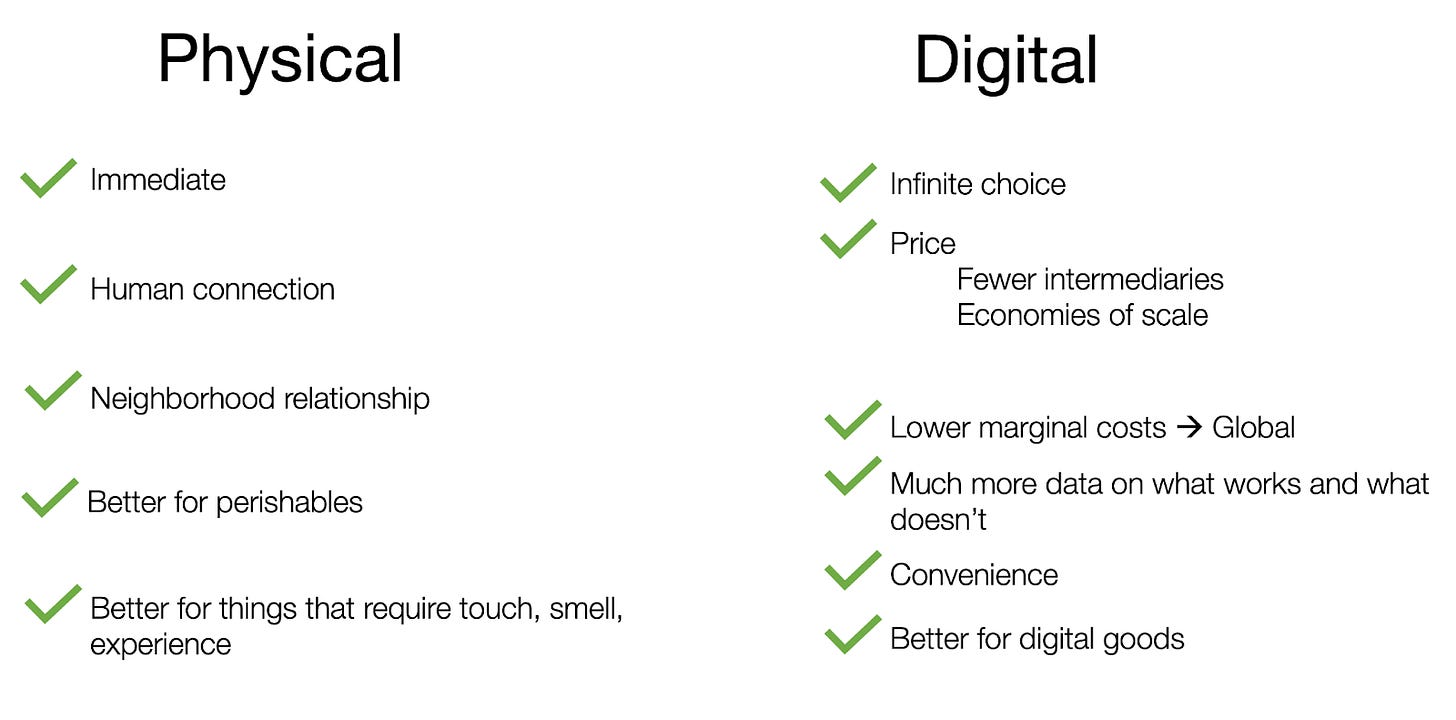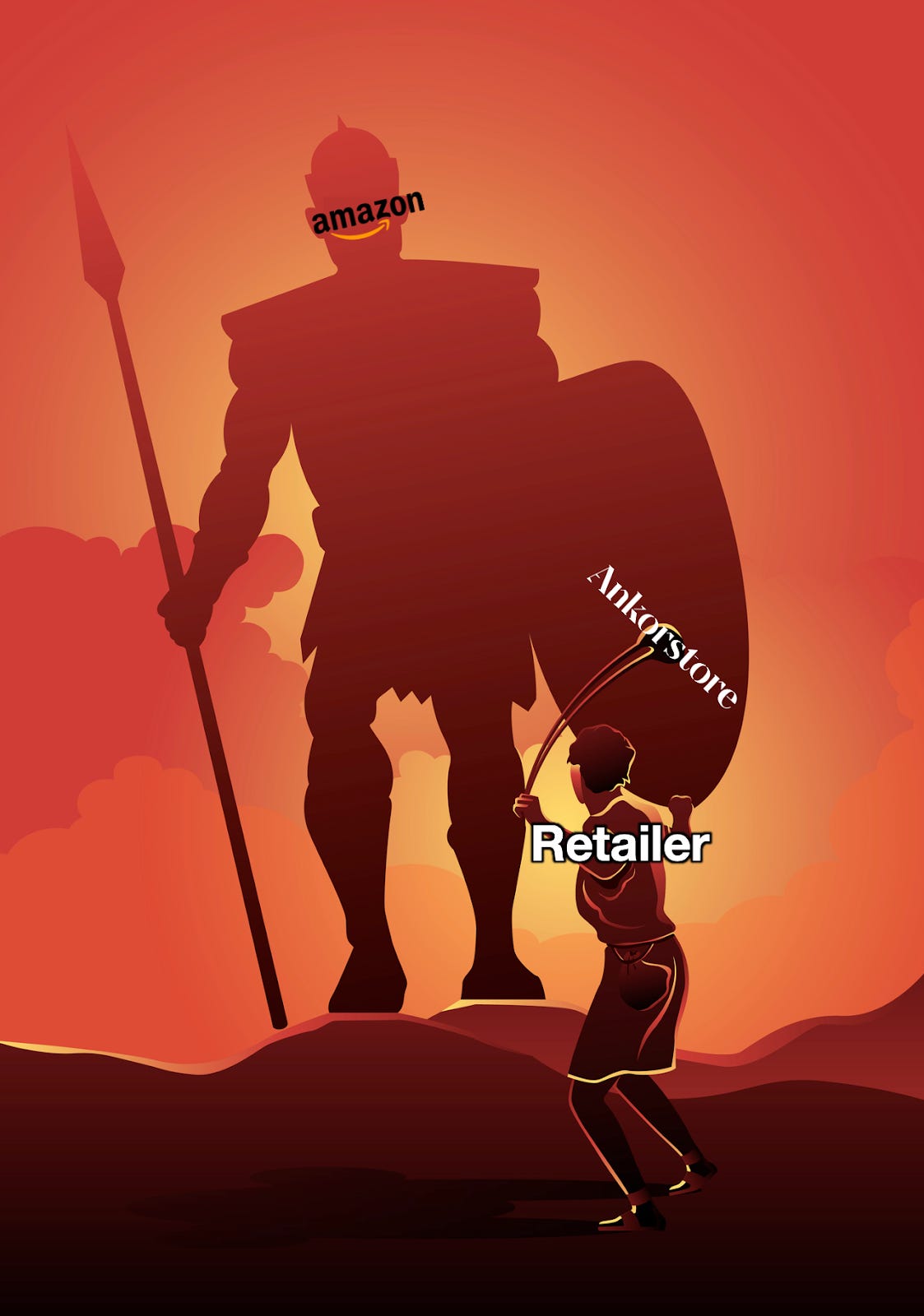How to Fight the Retail Apocalypse
And Some Personal News
I have some personal news to share. I am taking on Amazon.
I just moved to Europe to become the Chief Product Officer of Ankorstore, a two-year-old company that just raised nearly $300M at a $2B valuation, with some of the best Venture Capital investors in the world, including Tiger Global, Bond, Coatue, Index Ventures, Bain Capital1… It has grown its revenue by 10x in 2021, going 20 people to over 400 hundred. In 2022, we’ll get to the thousands.
What does this mean exactly? Why did I do it? How is Ankorstore taking on Amazon? Why is this relevant to you?
The answer is linked to saving the future of our cities and our jobs.
The Retail Apocalypse
Have you noticed how our public spaces are getting shittier?
Fewer people on the streets.
More boarded shops.
Emptier malls.
And it’s not just COVID. The virus has accelerated the demise, but everybody could read the graffiti on the wall.
This is definitely true in the US, but also in many places in Europe.
Retail stores continue to die off, like Sports Authority, Radio Shack, Forever21, Aéropostale, Toys ‘R’ Us, JC Penney, Sears… And those were before the pandemic. Others have since joined them, like Neiman Marcus, J. Crew, L’Occitane, Pier 1 Imports, Diesel…
Retail is the soul of our cities. When it dies off, the cities die with it. People don’t want to go to empty streets. When streets become empty, people don’t want to live there. The value of real estate drops. People flee declining areas. Fewer retailers open. The cycle feeds itself.
But when retail thrives, cities thrive.
People come to buy something and consume something else during their trip. Others see the liveliness of the streets and join them, buying some more. More people means more buying, so more retailers can open. Higher rents attract the most dynamic people, who want to live where it’s at. The higher rents entice more density, higher buildings, more people per square meter, more life in the streets, and the cycle continues.
So how do we turn this:
Into this?
This is important not just to save our cities, but also our jobs. The two biggest sources of employment are for retail salespeople and fast food workers2.
A world that replaces these jobs with something more efficient is a world with much more unemployment and inequality.
To solve a problem, we first need to understand it. So what has caused the retail apocalypse?
This is the fight between Mom & Pop shops vs. the humongous digital retailers.
The Digital Fracture
Even accounting for COVID, e-commerce represents a growing share of retail globally.
And the retail prize is big. Annual retail sales amount to $25T. Yeah, T for Trillions.
As Balaji Srinivasan says, every action we take online undermines the physical world.
Every email we send reduces the need for the post office.
Every crypto transaction undermines the bank branch.
Every book you buy on Kindle reduces the footprint of books and libraries and bookstores.
Every Instagram doomscroll reduces your trips to the mall for browsing.
Every Netflix chill a cinema seat kills.
As the Internet penetrated everything, it started undermining the physical world. It felt as if it would engulf it all. Why?
Before the Internet, most retail stores had a local monopoly, called a catchment area. If you were in that area and needed something from that type of store, you were most likely to go there and not somewhere else. You were much more likely to buy whatever the store had, even if it wasn’t exactly what you needed.
That obviously changed with the Internet. Now you have all the items in the world at your fingertips, usually at a lower price because you didn’t have to pay expensive real estate or a salesperson waiting whether there were customers or not. Digital companies like Amazon amortize all their technology across the world, switching variable costs (real estate, salespeople) into fixed technology costs. With better data, these digital companies were much better at telling you what products are good and which ones aren’t—that’s why, when you go to a retail shop, you check the item on Amazon to see the price and the reviews.
But when the pendulum goes in one direction, it overshoots. Over time, it goes back to the middle. Physical retail is not worse. It’s different.
Physical retail used to take advantage of its local monopoly. The appearance of digital retail destroyed that monopoly. But now that digital is here to stay, the physical retailers who adapt to this new world will learn to play to their advantages.
You can summarize the advantage of retail with this:
If you’re the type that likes human connection, physical retail is for you. More importantly, it allows for something that digital retail will never achieve: presence3. You can walk into a shop, smell the flowers, walk to the next one, touch the leather, compare the colors, try them on you, walk out with a bag in hand, catch somebody else’s eyes, escape their gaze looking down, sit down at a café, watch people walking…
There are two keys for retailers to be successful:
Play to their strengths: attract customers by creating experiences they can’t have online.
Mitigate their weaknesses: get as many of the benefits that online retailers have.
In the future I will write another article on the first point, how to create unique experiences in the physical world that we can’t get online. Today, I’m focusing on the second point.
The Retail Operating System
For retailers to play to their strengths, they need somebody to help them with their weaknesses. This is what Ankorstore does.
Imagine you dream of opening an independent retail shop, say, a concept store where you sell some clothes, some home decorations, some gifts… What do you need to do to make that happen?
You must come up with the concept, develop it, pitch it to financers, secure financing, find a location, lock a lease, contract works on the space, decorate it, and that’s just the beginning.
You need to be constantly searching for brands to source hundreds of products that are unique, tailored to your customers, can’t be easily found elsewhere, and which can be sold at a nice margin. You must then talk with the brands selling these products to understand their products better, their buying conditions, their ordering system… Once you make an order, you can’t track it; sometimes it takes forever for it to make it to your shop. When it does, sometimes it’s broken, sometimes your competitor gets the same product. When you handle your providers, you need to juggle with hundreds of invoices, returns, complaints, order status… You’re not always sure what sells well and what doesn’t, or the products you should reorder or not.
And that’s just to get the products to your shop. Then you need to find customers, work on your marketing, your sales, find employees, train them, make sure they represent the brand… You must set up your bank accounts, keep up with finances, taxes, customs, payments, payment systems, theft…
What would happen if retailers had an “amazon, but for buying wholesale products”?
Retailers could find millions of products in one place.
They could figure out which ones can’t be found anywhere else around.
They could see which ones sell best.
They could handle all their providers in one place.
They could have their payments update their inventory automatically, and the inventory trigger orders for the most successful items.
They could get help with marketing, finding end customers for their products.
They could get their finances and taxes automated.
Most of their problems can be simplified through technology, putting them at an equal footing with giants like Amazon. David could fight Goliath.
It’s also convenient for brands, because a decade ago, the main digital tool they could use was Amazon.
When Shopify (the $150B company) appeared, it gave brands another channel to sell through the Internet, this time directly to consumers.
Ankorstore enables brands to sell through independent retailers. With this, brands get digital access to a new channel to sell their products (retailers), while millions of retailers can use the power of digital to compete against Amazon.
Why This Matters to Me—and You
Both of my parents were retailers. My mother owned a small shop for Art de la Table4. My father owned an ice cream shop5. I spent my youth living the retailer life vicariously through them: the VAT they had to calculate every few months, the invoicing, the meetings to source new products, trade shows, investments in improving their shops… I saw them suffer when sales where short, when they suspected an employee of stealing, when rents increased, when a new competitor appeared with similar products
I saw the enjoyment and the struggle. When I got the opportunity to help millions of people like them get a fighting chance, I jumped in.
Ankorstore’s mission is not the only thing that attracted me. Customers love the product. Its NPS is in the 60-70 range6. The company multiplied its revenue by over 10x in 20217, and will likely continue its meteoric rise in the coming years. It has gathered over 200,000 retailers in Europe in the middle of a pandemic. The team I work with had 12 people six months ago. We’re 60 now and will get to 200 within the next six months.
What does this mean for Uncharted Territories? Nothing will change. I have been writing for six years now, started publishing three years ago (all while working), started Uncharted Territories in May 2021, and started collaborating with Ankorstore in July 2021. I’m just making it official now that I’m moving to Europe for it. Eventually, I’d like to work on UT full time. But UT is not big enough yet, and I just couldn’t say no to the Ankorstore challenge.
But here’s where it becomes relevant for you: how to invest your money and how to pick your next company.
How to Pick Winners
I joined my previous company, Course Hero, when they were worth a few hundred million dollars. They now serve over two million paying customers and just raised a new round at a valuation of $3.6B. I hope Ankorstore’s trajectory will be even faster. I want to believe I’ve learned how to pick companies. Ideally, not just for working, also for investing.
As you know, I strongly believe you should diversify your money and invest most of it in passive funds. But there are exceptions. If you want to invest in the market yourself, you can have a little bit of play money. Where to put it? You should concentrate your bets, which means if you have a much higher confidence than the market that something is an amazing investment—thanks to unique insight—you should bet on that.
In the next few weeks, I’ll share the insight I use to make my investment bets, whether in the companies I work for, the ones I invest in with play money, or even the cryptocurrencies I believe in.
Beyond that, there’s another way this news is relevant to you.
Join Me
As the Chief Product Officer (CPO), I’m in charge of deciding what digital products we will release and building the teams to make it happen, from a dozen or so people a few months ago to hundreds soon8, to support the company’s growth. My teams, and the rest of the company, are growing really fast.
I’m looking for stellar product managers, product designers, analysts, data scientists, product marketing managers, user researchers, frontend engineers, backend engineers, and QA engineers. And the rest of the company is also hiring: sales, operations, customer service, HR, finance… you name it. In total, we will probably hire 1,000 people in the coming year.
The company is headquartered in Paris, but it has hired people from dozens of nationalities, it’s remote first, and hires across all of Europe. So if you know world-class tech talent who might be interested in Ankorstore’s mission and growth prospects, please send them this article and ask them to apply here!
Tiger and Bond are leading the last round. Tiger Global is one of the savviest, most active funds in the world. It’s so powerful it’s changing Silicon Valley. Bond, an offshoot from historic Kleiner Perkins (formerly KPCB), is famous for Mary Meeker and her annual decks on Internet trends.
In the US.
Obviously, the metaverse is the wild card. As an owner of an Oculus Quest 2, I attest to how impressive VR is as an experience. There is a world where we will be able to recreate all the senses digitally. But despite what Mark Zuckerberg might hope, that will be very hard until we have brain implants, because not all senses are as easy to game as vision and hearing. Touch, equilibrium, and the ability to truly move anywhere without being hooked to a conveyor belt will be much harder to achieve in the metaverse without a brain implant. And Neuralink is just starting. I think it’s safe to say that we’re a few decades away from that, so for all intents and purposes, for you reading this article, you can consider that this will “never” happen.
Ever-efficient English speakers call it “tableware”, which is very descriptive of the function, but completely misses the art aspect.
At the beginning, it was exactly as exciting as it sounds. You get used to ice cream though.
NPS = Net Promoter Score. It’s a measure of how much your customers love your product or features. This range is world-class. To give you a sense, the average is around 20. The most beloved brands like Amazon or Apple are in the 80s, a company like Facebook is in the 30s. Banks and insurers tend to be below 0.
In fact GMS, Gross Merchandise Sales, the sales from the brands we support to the retailers who buy from them.
This is the type of work I’ve been doing for the last dozen years.






















I understand there is personal history involved ( parents in retail), but my view is as follows :
- consumerism produces to many shops initially and that is now being reversed.
- the boarded up shops should be replaced with trees / green spaces and / or hang out / activity places ( consume experience ) as opposed to shops ( consume goods)
- bringing back busy retail streets is like wanting to bring back horse and carriage . People realized they actually Don’t want to spend time going through and looking shops , carrying stuff back and they can get the human connection they need in other ways .
That there are so many other rewarding ways to spend time . That shopping is just a drag. This is a trend that’s now going to be reversed and it’s not only due to Amazon at all.
Speaking as a woman who buys clothes online ( and never in Amazon) - the physical browsing experience is just a time waste for those who don’t have anything better to do, you will never get the same choice at your finger tips as the various algos that find you the right thing in the right online shop. So you are not just taking on Amazon but all those guys and they r pretty clued up to what and how people want to find in terms of fashion . Sorry to be a buzz kill but there is much more here than just Amazon in terms of zeitgeist change
Hey Tomas,
First, congrats on the new challenge!
Looks like a great company!
Second, I am a founding member of UT and I hope you will still be able to work on UT because I really like your work!
Third, I Co-Founded weConnect (www.weconnect.co) and we specifically help companies like Ankorstore hire talent remotely across the world without their own entities and then we help set up legal entities in countries and handle compliance when needed.
We facilitate hiring remotely in 98 countries and set up entities and manage ongoing compliance in 58 countries.
My question to you is, do you think it would be possible to speak with someone at your company in HR, Legal, or Finance/Tax about how innovative weConnect is in our service industry?
Also, we just released our Expansion Blueprint article series which aims to explain international expansion from a strategic, technical and compliance standpoint and everything that needs to be taken care of A-Z when expanding internationally and it is written in a way your grandma could understand!
Let me know if we can connect!
My email is matthew.kyle@weconnect.co